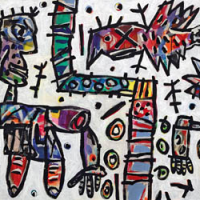
In a working career of just three decades, David Larwill managed to carve out an important place for himself in Australian art. His work was full of energy, enthusiasm, whimsy and imagination with a nave sense of fun that belied his intense interest and deep knowledge of the art of the past. A country boy from Ballarat, Larwill grew up on a rural property before moving to the Mornington Peninsula. As with many young art students, his early attendance at art school was less than successful, finding the new interest in art theory at odds with his own direct and spontaneous creativity. He travelled widely to gain valuable life experience before finding his niche at Preston Technical College, then going through a golden period under the direction of Betty Churcher (1931-2015). Teachers like Peter Booth (born 1940), Dale Hickey (born 1937) and Peter D. Cole (born 1947) were an inspiration, especially Booth whose 1979 exhibition at Pinocotheca Gallery proved a seminal moment for Larwill. Booths tough and aggressive paintings were a path out of the well-mannered good taste that dominated much of the art of the later 1970s.
In 1981 David Larwill joined with a large group of like-minded young artists to found ROAR studios, a collaborative and energetic new force in art in Melbourne. The ROAR painters were intensely urban in outlook, political and involved in the big issues of the day. Larwill found inspiration in a diverse range of sources, from prehistoric and Aboriginal art to the painters of the Angry Penguins. The expressionism of Tucker (1914-1999), Perceval (1923-2000) and Nolan (1917-1999), and in particular their own mentor Danila Vassilieff (1897-1958), fitted well with Larwills spontaneous and energetic approach to painting. After the cool minimalism of the 1970s and the dense theory behind so much new art of the 1980s, Larwill attacked his work with an anarchic and wilful disregard for the conventions of the day. As his canvases grew ever larger, he peopled his work with a range of figures and motifs that could be compelling and obtuse at the same time. The all-over patterning and disdain for formal notions of composition and draughtsmanship presaged in many respects the coming world of street art. Having seen the work of American artist Jean-Michel Basquiat (1960-1988) and the emergent street art scene in New York in 1992, he was energised by the sense of anarchy and raw energy in the tags and graffiti rampant in the city.
While Larwill drew from a wide range of influences, it was his relationship with Australian Aboriginal art that came to define his later career. As desert painting came to be part of the mainstream, he travelled to the source to gain an understanding of the deeper cultural meaning as well as the immediate surface appeal of both new and ancient Indigenous art. Travelling to the outback also brought him to the important political and environmental causes that were facing outback communities and he used his growing influence in such campaigns as the opposition to the Woomera nuclear waste dump site and the expansion of the Jabiluka uranium mine. Just Following Orders takes the loaded epithet so often trotted out in response to accusations of the most outrageous crimes, the cry that individual responsibility is subservient to official direction, no matter how evil the crime. From Nuremburg to the My Lai massacre and on to Iraq and Afghanistan, it has been the cop-out for perpetrators on every side. Larwill has depicted a scarifying scene with dismembered bodies and a wilful protagonist, part street thug, part soldier. Guernica meets Lichtenstein in an angry cry from the heart. Larwill fought for many causes but, like many an idealist, he died too young. His youthful face and amiable demeanor belied a powerful will with art as its weapon.
Gavin Fry BA[Hons] MA. MPhil
